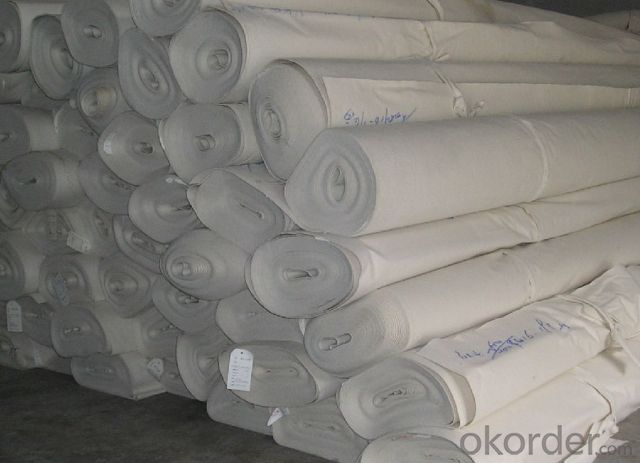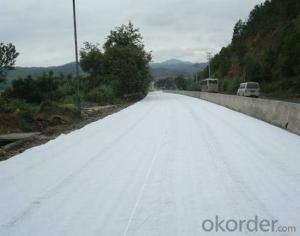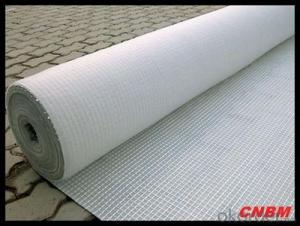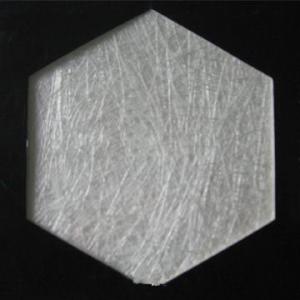PP Woven Geotextile Membrane Price for Road Construction Project
- Loading Port:
- Qingdao
- Payment Terms:
- TT OR LC
- Min Order Qty:
- 20000 m²
- Supply Capability:
- 1500000 m²/month
OKorder Service Pledge
OKorder Financial Service
You Might Also Like
Specifications of PP Woven Geotextile for Road Construction Project:
-Weight / Mass: 75g/m2-800g/m2 .
-Width: Within 8 m (1m-8m).
-Length: 50m-100m/roll (as request).
-Material: PP/PET.
-Color: Black , white , grey, others
-Certificate: CE/ISO9001, ISO14001 .
-Manufacturing method: nonwoven / woven.
-The equipment is introduced from Germany.
-This geotextile can be made of polypropylene (PP), or polyester (PET), Polyvinyl or synthetic fiber on needle punch machine.
-The mass is available from 75g/m² to 800g/m² and the width available from 1.0m-8m, monolayer or multilayer (reinforcement geotextiles), long fiber or short fiber.
-Color: all kinds of color are available. The annual production ability is 10 million square meters.
-The fabric can also be heat treated by infrared at customer's requirements. Our geotextile are UV stabilized to give protection against aging under exposure to natural ultra-violet light.
Introduction of PP Woven Geotextile for Road Construction Project:
Geotextiles are composed from synthetic polypropylene/polyester fibres through a mechanical process of needling the fabric and adding, when necessary, a thermo fused process, resulting in a uniform porous structure with excellent tensile strength and chemical deterioration. Type: 1. Wovens & knitted: use various fibre types (e.g. monofilament, multi-filament, split extruded film) in different combinations. 2. Non-wovens: staple or continuous fibres that are heat treated or needlepunched to “fix” fibres relative to each other.
Technical Parameters of PP Woven Geotextile for Drainage Function:
100 | 150 | 200 | 250 | 300 | 350 | 400 | 450 | 500 | 600 | 800 | NOTE | |
BASIS WEIGHT TOLERANCE (%) | -8 | -8 | -8 | -8 | -7 | -7 | -7 | -7 | -6 | -6 | -6 | |
THICKNESS ≥MM | 0.9 | 1.3 | 1.7 | 2.1 | 2.4 | 2.7 | 3.0 | 3.3 | 3.6 | 4.1 | 5.0 | |
TENSILE STRENGTH AT BREAKING ≥KN/m | 2.5 | 4.5 | 6.5 | 8.0 | 9.5 | 11.0 | 12.5 | 14.0 | 16.0 | 19.0 | 25.0 | MD&CD |
CBR PLUNGER STRENGTH ≥KN | 0.3 | 0.6 | 0.9 | 1.2 | 1.5 | 1.8 | 2.1 | 2.4 | 2.7 | 3.2 | 4.0 | |
TEARING STRENGTH ≥KN | 0.08 | 0.12 | 0.16 | 0.20 | 0.24 | 0.28 | 0.33 | 0.38 | 0.42 | 0.46 | 0.60 | |
BREADTH TOLERANCE (%) | -0.5 | |||||||||||
ELONGATION AT BREAKING (%) | 25-100 | MD&CD | ||||||||||
EOS O90mm | 0.07-0.2 | |||||||||||
VERTICAL PERMEABILITY (CM/S) | K×(101~~103) | K=1.0-9.9 | ||||||||||
RFQ:
What is the main application of Road Construction Project:
The main application of our Road Construction Project:
is as follows: The highway, railway, soil-stone dam, breakwater, airport, backfill soil of retaining wall, slope protection, etc.
Where is your main market?
Our main market is in Middle East, South America and some African countries.
What is your advantages for Road Construction Project:
One of the largest manufacturer of Road Construction Project
with advanced equipment, big production capacity and excellent quality.
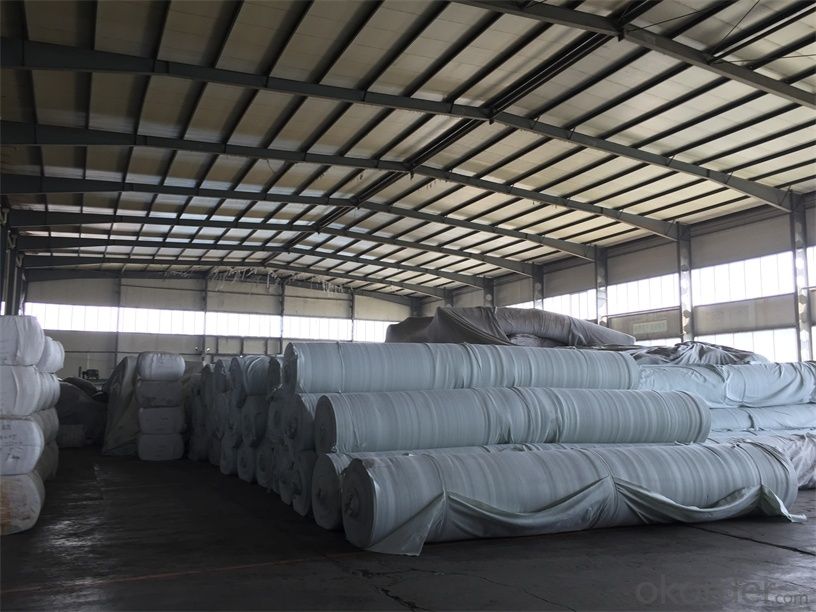


- Q: What can the geotext crushed material be used?
- Can continue to be used to do geotextile, but because the geotextile after the strength of the fiber is affected, can only be crushed after the geotextile for the production of low grade geotextile, for example, the national standard geotextile crushed material can generally be used Non-standard geotextile production, but in strict accordance with the proportion of added, should not add too much crushed material.
- Q: Can geotextiles be used in geosynthetic reinforced walls?
- Yes, geotextiles can be used in geosynthetic reinforced walls. Geotextiles are commonly used as a separation and filtration layer in geosynthetic reinforced walls. They help prevent the migration of fine particles and provide stability to the soil layers, enhancing the overall performance and longevity of the wall.
- Q: What are the key factors affecting the hydraulic conductivity of geotextiles?
- The key factors affecting the hydraulic conductivity of geotextiles include the porosity of the fabric, the size and shape of the openings or pores in the fabric, the fabric thickness, and the surface roughness of the fabric. Additionally, the type and quality of the fibers used in the geotextile can also impact its hydraulic conductivity.
- Q: How do geotextiles improve the performance of geocells?
- Geotextiles improve the performance of geocells by providing additional reinforcement and stabilization to the structure. They act as a barrier, preventing soil erosion and promoting effective soil confinement within the geocell system. Geotextiles also enhance the load distribution across the geocell walls, increasing the overall strength and stability of the structure.
- Q: How do geotextiles help in soil reinforcement?
- Geotextiles help in soil reinforcement by providing a strong and stable base for the soil. They act as a barrier between the soil and other materials, preventing erosion and maintaining the integrity of the soil structure. Additionally, geotextiles distribute the load evenly across the soil, reducing the risk of settlement and increasing the overall stability of the area.
- Q: Construction scheme of geotextile water filter
- Second, the design: program one: in strict accordance with the requirements of the national standard construction, 5-year warranty 1, in the smooth level of leveling the overall construction brushing JS waterproof latex or polyurethane waterproof coating, the thickness of the national standard 1 standard; Weak parts to do additional layer to strengthen; 2, do 20 ~ 30mm thick waterproof mortar protective layer, divided into two construction, layer waterproof layer of pulp interface; require nano-silicon waterproofing agent and expansion agent compound use. 3, backfill when asked not to smash the waterproof layer. 4, indoor ground practice ibid, the wall to do high 1m. Option 2: with reference to national standard requirements simple practice, the warranty period of 1 year 1, the overall construction of coated asbestos asphalt waterproof coating or waterproof cold primer, the thickness of the standard by the national standard 2; special weak parts to do additional layer to strengthen; Outside the protection, requiring the use of sticky or sticky sticky construction; 3, backfill when asked not to smash the waterproof layer. 4, indoor ground practice reference program one, the wall to do high 1m.
- Q: Can geotextiles be used in the protection of retaining walls?
- Yes, geotextiles can be used in the protection of retaining walls. Geotextiles are permeable fabrics that can provide reinforcement and stabilization to the soil behind the retaining wall. They can help prevent erosion, reduce water pressure, and improve the overall stability and longevity of the retaining wall.
- Q: Can geotextiles be used for erosion control in mining sites?
- Yes, geotextiles can be used for erosion control in mining sites. Geotextiles are permeable fabrics that are often used to stabilize soil and prevent erosion by separating, filtering, and reinforcing different layers of soil. In mining sites, where the land is disturbed and susceptible to erosion, geotextiles can be employed as an effective erosion control measure. They can be used to cover exposed soil, reinforce slopes, and retain sediment, minimizing erosion and protecting the ecosystem.
- Q: Can geotextiles be used in embankment reinforcement?
- Yes, geotextiles can be used in embankment reinforcement. Geotextiles are commonly used in civil engineering projects to improve the stability, strength, and durability of soil structures such as embankments. They are placed within the soil layers to provide reinforcement, filtration, and drainage capabilities, reducing the risk of erosion and enhancing the overall performance of the embankment.
- Q: How do geotextiles aid in the protection of geomembranes?
- Geotextiles aid in the protection of geomembranes by acting as a barrier between the geomembrane and the surrounding soil or aggregate. They provide cushioning and support, preventing direct contact and potential damage to the geomembrane from sharp objects or uneven surfaces. Additionally, geotextiles can assist in preventing soil erosion and the migration of fine particles, enhancing the overall stability and longevity of the geomembrane installation.
Send your message to us
PP Woven Geotextile Membrane Price for Road Construction Project
- Loading Port:
- Qingdao
- Payment Terms:
- TT OR LC
- Min Order Qty:
- 20000 m²
- Supply Capability:
- 1500000 m²/month
OKorder Service Pledge
OKorder Financial Service
Similar products
Hot products
Hot Searches
Related keywords








